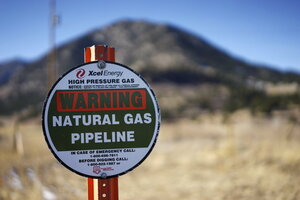Is natural gas facing the same problems as the oil market?
Natural gas production has reached record heights in recent years, causing prices to plummet.

A sign marking the location of a natural gas pipeline is seen in Golden, Colorado, February 2, 2015. Americans are likely to see their lowest heating bills in years thanks to a glut in the domestic fuel supply and predictions of milder winter weather, they say.
Rick Wilking/Reuters/File
Natural gas prices have fallen to their lowest levels in three years, plummeting by more than 10 percent on October 26.
The balance of natural gas supply and demand typically goes through seasonal fluctuations, with inventories building during the summer months in North America as surplus production is diverted into storage. Then in winter months consumers drawdown on natural gas inventories as heating demand spikes.
But natural gas production has reached record heights in the last two years pushing down spot prices to multiyear lows. After consistently trading at or above $3 per million Btu (MMBtu) for much of the last three years, Henry Hub spot prices have dropped below that threshold in 2015 as production continued to climb through much of this year.
More recently, prices have declined to fresh three-year lows due to the possibility that warm weather and ample supplies could lead to a smaller drawdown in the coming winter months than usual. Henry Hub sunk below $2.10/MMBtu during midday trading on October 27, a level not seen since the first half of 2012.
However, low prices could cut eventually sow the seeds of a renewed rebound by putting long-term investments in new sources of supply at risk. In the more closely watched oil sector, a glut in supply is leading to severe cutbacks in spending which could ultimately threaten long-term supplies. A lack of drilling new shale wells is already contributing to a decline in U.S. oil output. Eventually, supply will contract to a point that will force prices back up.
The same trend could be unfolding in natural gas markets. The collapse in rig counts has halted not just oil production, but also gas production. Natural gas is produced in association with oil, so when oil drillers stop drilling, gas production falls as well.
But it goes beyond low oil prices. In the Marcellus Shale, the most prolific region for gas production in the United States, but not a major oil-producing region, natural gas output peaked earlier this year and is now in decline, according to a recent EIA report.
“In the US, $3/MMBtu gas is really not sustainable in the long run if you want to continue to have the abundance. A movement toward $4-$5/MMBtu is likely needed to continue to aggressively pursue resources,” Mel Ydreos, chairman of the coordinating committee at the International Gas Union (IGU), told Platts in an interview.
Gas selling close to $2/MMBtu will damage the bottom line of natural gas producers. For example, Southwestern Energy Co., a Texas-based producer of natural gas, announced a $1.77 billion net loss for the third quarter, down from a net profit of $211 million for the same period in 2014. Glaringly, revenues fell despite the fact that the company managed to increase production.
With natural gas prices so low, the gas rig count has collapsed, down to 193 in the U.S., about half of what it was a year ago. That means gas companies are drilling fewer new wells, and as a result, depletion is overtaking new production. Shale gas production in the Marcellus, for example, is expected to fall by 215 million cubic feet per day in November compared to October.
Oil and gas markets are oversupplied, but a glut in yet another sector is also affecting prices. A long queue of major LNG export terminals are coming online at a time when demand cannot keep up. That has pushed down spot prices for LNG cargoes delivered to Asia from a high of $20/MMBtu in the first quarter of 2014 down to below $8/MMBtu currently.
Depressed pricing is deterring investment for new capacity as markets appear oversupplied for years to come. “We're seeing investments being curtailed in some of the next tranche of early LNG developments,” IGU’s Ydreos said.
Just as in oil, oversupply has pushed down prices. And in similar fashion, a slowdown in drilling is necessary before prices rebound to sustainable levels. And with production now falling, the rebound will have to come eventually.
Source: http://oilprice.com
Original article: http://oilprice.com/Energy/Energy-General/NatGas-Glut-Mirrors-The-Problems-Facing-Oil-Markets.html

